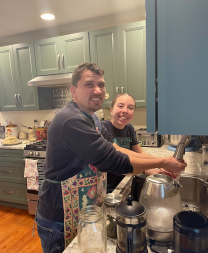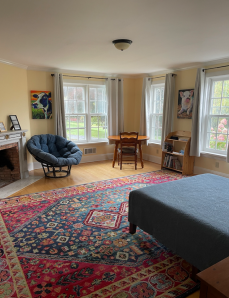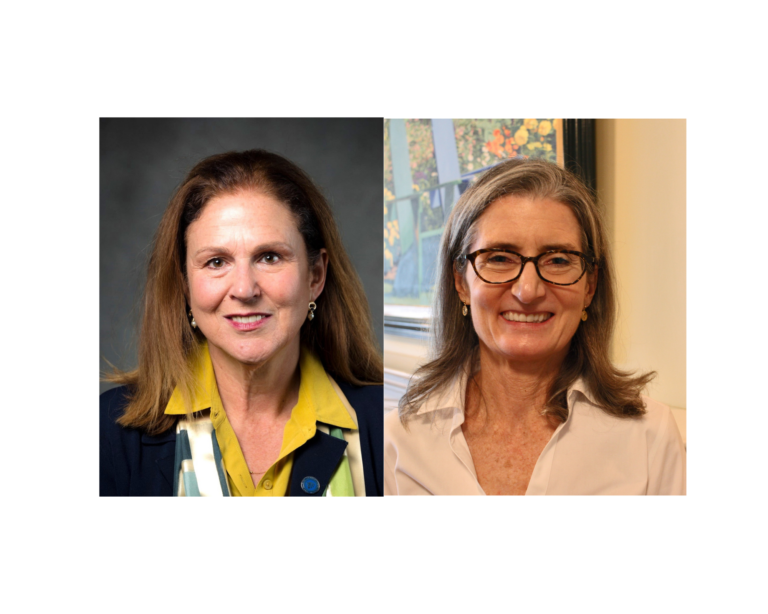Opened in October 2024, Riverflow Community offers a new housing option for adults with intellectual and developmental disabilities in Vermont, but advocates say many more are needed.
By Emily Bradbury
On a cold, bright day in January, Jesse returned home to Riverflow Community after visiting his mother for the holidays. “He just came running toward me and kissed my cheek and exclaimed, ‘Riverfloooow!’,” said Hannah Schwartz, executive director of the organization. “He went around to each person and said their name and hugged them. It was such a moment of joy for everyone. I was like, ‘Okay, we are doing this’.”
Jesse, who has Down Syndrome Regression Disorder and will require lifelong supervision, is one of the four founding “Friends” at Riverflow, an intentional community for adults with intellectual and developmental disabilities. Opened in October 2024 in Monkton, Vt, Riverflow is one of a very few housing options for adults with developmental disabilities in Vermont, which has relied almost exclusively on a shared-living model since the closing of the institution at Brandon Training School in 1993.
That is something that an organized and growing group of advocates is trying to change.
“In a stressed and chaotic world, I am so grateful that Jesse is now living in a beautiful and stable community,” said Elizabeth Campbell, Jesse’s mother. “I do have to admit that I also feel some guilt, sort of like a passenger on the Titanic who has found a lifeboat. There are just so many parents who live with chronic fear about their adult child’s lifelong vulnerability. We have to build more houses, and fast.”
The urgent need for housing
A recent report found there are more than 600 adults with intellectual and developmental disabilities living with aging parents in Vermont. These individuals are eligible to receive services through the public school system until the age of 22. At that point, many move into shared-living situations, essentially adult foster care arrangements, where they are placed with a family that is compensated to take on their care and supervision. Federal rules prevent parents from being paid caregivers.

A survey by five state designated agencies found that 25 percent of current shared living providers are planning to retire in the next five years.
“It’s a very vulnerable system,” said Schwartz, noting Vermont’s aging population and acute shortage of both affordable housing and skilled health care providers. “All the issues affecting Vermonters right now, they impact a person with intellectual challenges tenfold. If someone moves or retires, it’s the individual with developmental disabilities that is unhoused.”
“I’m 67 years old,” said Campbell. “There is just no way I could go to my death knowing my son would be a guest in a series of strangers’ homes.”
Schwartz notes that nationwide more than 7.2 million individuals between the ages 3-21 receive special education services. “That’s 15 percent of school students,” she said. “We have to take seriously the imperative to increase joyful, safe, and dignified living options for individuals leaving their educational supports.”
A plea for “safe, stable places”
Riverflow offers one such option. Inspired by the Camphill Movement, a global initiative for social change with more than 100 communities worldwide, the intentional living model provides loving, therapeutic care for people with intellectual and developmental disabilities.
“We look at the whole human; body, soul, and spirit,” said Schwartz. “Each needs care. How is a person’s body and nutrition? Do they need help with speech and communication? Emotionally, what are they bringing with them? Is there trauma? What is their religious life? It’s all built into their care.”
That kind of environment, where community members feel celebrated and understood, is something Campbell and her husband sought for years for their son. During the pandemic, her husband was diagnosed with glioblastoma, a rare and terminal brain tumor. When he passed, she was catapulted into action to try to secure Jesse’s future.
“Few people are more motivated than parents of lifelong vulnerable adult children,” she said. “We’re fearful and, of course, we’re all aging.”
She wrote a commentary making a plea for “safe, stable, service-supported houses” where her son and others could live with friends and began hearing from other parents. She distributed a petition advocating for additional housing options, garnering over 700 signatures from families throughout Vermont, and subsequently founded the Developmental Disabilities Housing Initiative (DDHI), a volunteer-based, parent-run group that now has over 100 members from every county in the state.

Marla McQuiston in Williston, whose adult son has Down Syndrome, is among the group of parents leading DDHI. “The pandemic created Zoom,” said McQuiston, “and parents that had been in isolated pockets of Vermont were able to gather and connect with each other. That’s where our advocacy really began.”
Campbell, McQuiston, and Jim Caffry, a Vermont-based special needs lawyer, are among a core group who are advocating relentlessly for housing options for adults with developmental disabilities. They have been successful in raising awareness among decision-makers and the general public and, with support from several key legislators and Alex Farrell, Vermont’s Commissioner of Housing and Community Development, were the driving force behind the passage of Act 186, which Campbell calls a “paradigm shifting” piece of legislation.
Passed in 2022, Act 186 established funding for pilot planning grants that would address housing needs for people with intellectual and developmental disabilities. Grants have been awarded to three organizations including Riverflow, Upper Valley Services, and Champlain Housing Trust.
“The pilot planning grant funds have been essential to Riverflow’s success,” said Campbell, a founding parent of Riverflow along with Jim and Amy Caffry. “The most important consequence, however, is that Vermont is now open to housing options that address the wide range of needs in the developmental disability community and is ready to learn from other states that are farther along.”
“We need to get this pipeline flowing,” said McQuiston. “It’s a small state and there is such a high need. This group of Vermonters has been underfunded for too long.”
Working toward financial sustainability
Frank Cioffi learned about DDHI and the Camphill Movement after adopting his grandson, Frankie. His daughter, Alexa, died unexpectedly in 2016 and Frankie, just two years old at the time, was diagnosed with autism spectrum disorder that same year.
“Like hundreds of other parents with children who have intellectual or developmental disabilities, I was terrified. None of us are going to live forever. I needed a plan and I wanted something that would be a good fit for Frankie.” He visited a small, therapeutic care residence in Vermont and, at the end of the tour, asked how he could buy in. “You can’t,” was the answer. “I appreciated that,” said Cioffi, “because it showed me what had to be done.”
President of the Greater Burlington Industrial Corporation (GBIC), Cioffi saw the gap in housing options for individuals with disabilities across Vermont as a problem to be solved. “That’s what GBIC does. We identify tough problems and then figure out what needs to be done. We have the experience in real estate, development, and government relations to help move this forward.”
He connected with McQuiston and DDHI. “These moms are a force of loving and purposeful determination,” he said. “They are so deeply knowledgeable in so many areas.” The GBIC board of directors engaged Downs Rachlin Martin (DRM) to provide government affairs help for the DDHI Group and Riverflow.
DRM is working on a $2.7 million state appropriation to create a DDHI and Champlain Housing Trust model home or apartment complex. They also worked with the Vermont Department of Housing and Community Development to help secure a $240,000 grant from the Vermont Housing Improvement Program to help Riverflow offset renovation costs at Riverflow Community’s Willow House in Monkton. This 2025 legislative session, DRM and GBIC are working with the DDHI Group and developmental disabilities advocates to find more resources to help create housing for people with intellectual and developmental disabilities.
Cioffi is now chair of Riverflow’s board of directors and is working to help Riverflow Community finish its first home and plan for the other homes. “In order to be sustainable, I don’t think that we can afford to have any debt,” explained Cioffi. “There is not enough money that comes to a person with special needs to cover a mortgage payment; that money is for housing, food, and services that will help them function in life. So, every property has to be paid off.” Riverflow is currently pursuing a $420,000 grant from the Vermont Housing Conservation Board that would allow the group to pay off its mortgage.

“We need to fund every house we build,” said Cioffi, “and then we need to build an operational reserve endowment and a capital endowment. That’s our goal. We are very encouraged by the support and dedication of Vermonters in government departments and agencies, the legislature, and various disability specialists that are working together to create more lifetime housing for people with intellectual and developmental disabilities. Time is not our friend. We have to get this going.”
Advocating for options, stability, community
The full build-out envisioned for Riverflow includes three additional houses, a group of tiny homes, a therapeutic barn, walking paths, and a greenhouse. At that size, Riverflow could serve up to 16 members in four lifesharing homes. “It’s daunting but I just know it will happen,” said Schwartz. “We’ve been open for three months and already have 75 applicants.”
While the Riverflow Community represents a bright spot for people living with intellectual and developmental disabilities, it’s only a first step.
“We got kind of lost as a state,” said Cioffi. “Closing Brandon was the right thing to do, but we stopped there. It’s a real challenge. We’re speaking up for people who can’t speak for themselves and who don’t have the money or resources to advocate for themselves.”
“These are not people out causing problems on the street, so they’re not getting attention,” said McQuiston. “Nobody really knows about them because they are being taken care of somewhere, by somebody. It’s a silent tax on the families who choose to drop out of the workforce rather than send their child into a shared-living situation.”
“We need a bigger advocacy circle and voices,” agreed Schwartz. “DDHI is amazing at pulling in parents. We need people with disabilities talking about what it’s like to live in shared-living situations. We need national research on the best models. Disability housing needs to be very thoughtfully placed in the middle of the housing conversation because it’s our most vulnerable population.”
Schwartz, Cioffi and the parents involved with DDHI all point to one central goal for the future: more options and a funding stream to sustain them.
Camphill-inspired communities, like Riverflow, are one. Supervised apartments are another. New technological advances that supplement in-person supervision with virtual support, for example to remind a person when medication is due or to turn off the faucet, are also becoming a possibility. For some families, shared-living may be the best choice. “It’s the premise that one-size-fits all that is flawed,” said Schwartz.
The group also agrees that in a rural state, community is critical. Riverflow offers the Friends living there feedback that may not come from a parent. That feedback and support translates from Riverflow into the broader community, says Schwartz.
“There are a lot of behaviors we see that will prevent a person from accessing the respect and connection that he wants in the world,” she said. “We talk about those things and approach them with curiosity. Why is that person angry? Did something happen or does he have a rock in his shoe? What does friendship look like? We get to meet them as adults and codiscover with them how they want to live their lives.”
Campbell was astounded to notice tears streaming down Jesse’s cheeks in the car when she picked him up from Riverflow to bring him home for the holidays. “He’s minimally verbal and rarely cries,” she said. “When I reassured him that Riverflow was his home now and that he’d be coming back soon, his tears stopped and his face just lit up.”
“These are young adults who have grown up in Vermont’s tight-knit communities,” said McQuiston. “Our son can’t go anywhere without someone saying hello to him. He wants to stay in a community.”
“We all want community,” said Schwartz. “We all know we need to care about each other more. I have a deep love for people with neurodifferences. They have so much value and authenticity. They just want to know you and be known; it’s not transactional. Building that kind of joyful connection that not only includes, but also celebrates people with different needs benefits all Vermonters.”
“There is something about this model that makes us care more about each other and it spreads,” she said. “Everybody catches it.”
To learn more: riverflowcommunity.org


